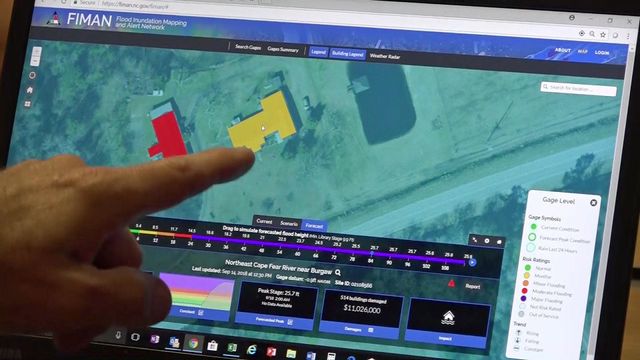As inland waters rise, state keeps wary eye on 167 high-risk dams
Much of the flooding danger isn't predicted to peak until days after Florence's rainfall is long gone. These online tools can help you see where the danger will be.
Posted — UpdatedAnd even as partly sunny skies return next week, much of the flooding danger isn't predicted to peak until days after the storm's rainfall is long gone.
"More people now face imminent threat than when the storm was offshore," Gov. Roy Cooper said in a statement Saturday afternoon. "I cannot overstate it: Flood waters are rising. If you aren't watching for them, you are risking your life."
Record-breaking flooding to come
Predictions as of Saturday from the National Weather Service show the potential for major flooding at 13 sites the agency monitors in North Carolina, from the Yadkin River northwest of Charlotte to the southeast coastal plain. For many of those gage sites, like those in the Neuse and Lumber rivers, floodwaters aren't expected to crest until as late as Thursday morning.
"Even though this storm is dropping down into South Carolina, Charlotte and the western part of the state are going to experience some significant flooding as well," John Dorman, an assistant director with state Emergency Management, said. "This is a statewide event."
Five of those sites – the Little River near Manchester, three places along the Cape Fear River and the Lumber River near Lumberton – are likely to break previous flooding records set during Hurricane Floyd in 1999 and Hurricane Matthew in 2016.
Predicted major flooding
It will allow officials like Dorman to adapt as the storm's most damaging impacts shift away from storm surge.
"Flooding's coming up to New Bern. Flooding's coming up to Greenville," Dorman said in an interview Friday. "But that flooding's going to go back down because it's coastal influence. Everybody's going to see a sunny day at some point in time and say, 'We're good.' Well actually, you're going to get sunny day flooding coming from the water further up in the basin."
North Carolina residents can use the FIMAN site to create personalized alerts for their area and see how flooding will impact property around swollen creeks and rivers when waters reach their crests – including predictions of how high the water will rise in affected buildings.
In an area just northwest of Burgaw, N.C., on the Cape Fear River, for example, waters are expected to rise 20 feet above normal by Tuesday morning. If that happens, more than 500 buildings will see damage totaling more than $11 million. More than 100 structures there could see five feet of water or more.
Dorman said he's watching these areas closely as now-Tropical Storm Florence continues to dump more than 20 inches of rain in some areas as it creeps along North Carolina's southern border.
"The way that the storm is tracking now to the west and southwest, I do believe the Lumber River Basin, Robeson County, Columbus County – that had such a difficult time with Matthew – I think they're going to receive a significant amount of rain," he said.
Emergency officials watching high-risk dams
Continued heavy rainfall also poses threats to several of the 167 high-hazard dams that have received either poor or unsatisfactory assessments from state inspectors in recent years. High hazard dams are structures that would cause death and significant property destruction if they fail.
Seven of those dams are in locations with forecasted rainfall of 15 inches or more over the next week, according to National Weather Service data.
Heavy rain at high hazard dams
Most of the state's 167 impounding high-hazard dams rated poor or unsatisfactory, shown here in purple, lie in areas across North Carolina with predicted rainfall totals of 5 inches or more, according to 7-day rainfall predictions from the National Weather Service.
Those locations include the dam shoring up a coal ash storage pond at Duke Energy's Weatherspoon Plant in Robeson County, last assessed by state regulators in poor condition in 2017.
Paige Sheehan, a spokesperson for Duke Energy, said the company has worked to prepare for potential flooding at its coal ash sites and cooling ponds by pre-staging equipment and staff to respond quickly if required. And because the company has been working to close many of the ash ponds, Sheehan said water levels are lower and can accommodate more rainfall.
"As soon as the storm passes and it's safe to do so, our plant crews will perform inspections to assess damage and understand any site maintenance needs," she said in a statement.
From the emergency operations center, Dorman said their flood inundation mapping system doesn't have the capability to predict how flooding will impact the dams directly. But he said officials there are working with state regulators and local county emergency managers to keep an eye on the about 1,500 high hazard dams scattered across North Carolina – particularly the ones in the areas of heaviest rainfall.
The state's FIMAN system does have some limitations – not all of its gage sites have predictions built-in.
Its data are also only as good as its sensors. The site at Oriental, N.C., on the Pamlico Sound was faithfully beaming back the trajectory of rising waters in Oriental until some time overnight Thursday, when it blinked off the map.
"The surge just took it out," Dorman said.
But overall, Dorman said he's hoping FIMAN will continue to be a valuable tool for emergency managers and the public alike.
"We're watching the numbers, waiting to hear from NOAA and the National Weather Service," Dorman said. "I think our gages and sensors are telling some things, so hopefully we'll get ahead of it and stay ahead of it."
Related Topics
• Credits
Copyright 2024 by Capitol Broadcasting Company. All rights reserved. This material may not be published, broadcast, rewritten or redistributed.






